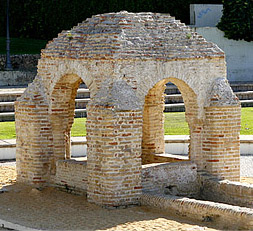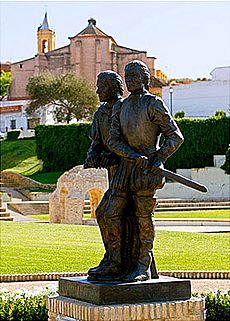Fontanilla facts for kids

The Fontanilla is an old public fountain in Palos de la Frontera, Spain. It's famous because, people say, it provided water for Christopher Columbus's ships. These ships were the Santa María, the Niña, and the Pinta. They left Palos on August 3, 1492, led by Columbus and the Pinzón Brothers. This journey is widely seen as the start of the "Age of Discovery" and the "discovery" of the New World (the Americas).
The Fontanilla is a very special and real monument among the "Lugares colombinos". These are places in Huelva, Spain, that are closely linked to Columbus's first trip.
The Fontanilla: History and Design
There were two main places to get water in Palos. One was the fountain of Villafrías. The other was the Fontanilla, located just outside the old town. A small arm of the Río Tinto river reached almost to its base. This area had a pier, which was the easiest way to reach the town from the sea. It is very likely that Columbus's ships sailed from this very pier.
If you walk from the Puerta de los Novios (Lovers' Gate) of the Church of Saint George the Martyr, you will find the Fontanilla. This old public fountain sits on a base that dates back to Roman times. It is protected by a stone structure called a tetrapylum, which is like a gazebo. This structure was built in the 13th century in the Mudéjar style.
The tetrapylum has a square base. Its roof is shaped like a half-dome on the outside and a pyramid on the inside. It is supported by four slightly curved semicircular arches. These arches rest on strong pillars that are made even stronger by abutments (supports).
When the fountain was in use, the water came out in the middle. It then flowed along open channels on the sides. The water collected in a long trough on the eastern side. Recent studies show that the Fontanilla was once covered in stucco and painted in a yellow-brown color called ochre. It also had religious pictures.
Because it was at the entrance to the city, the Fontanilla was more than just a public fountain. It was a place for travelers to rest and cool off. It might also have been a cruz de término or humilladero. These were types of roadside shrines at the entrance to a town. They were places for prayer and quiet thought, offering rest for both the body and the spirit. It was similar to other humilladeros in Andalusia, like the Cruz del Campo in Seville.
Today, the Fontanilla has been repaired and has a brick finish. The only wooden part is a gargoyle where the water comes out. You can see the Fontanilla from the road leading into Palos from Moguer. You can also view it from a high point on the hill where the town is built, looking down at its surrounding gardens.
See also
In Spanish: Fontanilla para niños


